It’s glorious, that first bite of a warm pastrami sandwich on freshly baked rye. If you’ve ever eaten pastrami at a great Jewish deli, you know what I’m talking about. That moist, tender meat topped with spicy mustard is enough to make almost anyone swoon. When my husband and I took the Queen Mary from London to New York several years ago, we docked at 6:00am and found that we were hungry. Our first stop? Katz’s Deli for a pastrami on rye. It didn’t matter that the sun was barely up. Pastrami is good any time, day or night. When the appetite strikes, you must feed it. Trouble is, many of us don’t live close to a great Jewish deli, and mediocre pastrami can be SO disappointing. What can you do? Make it at home, that’s what!
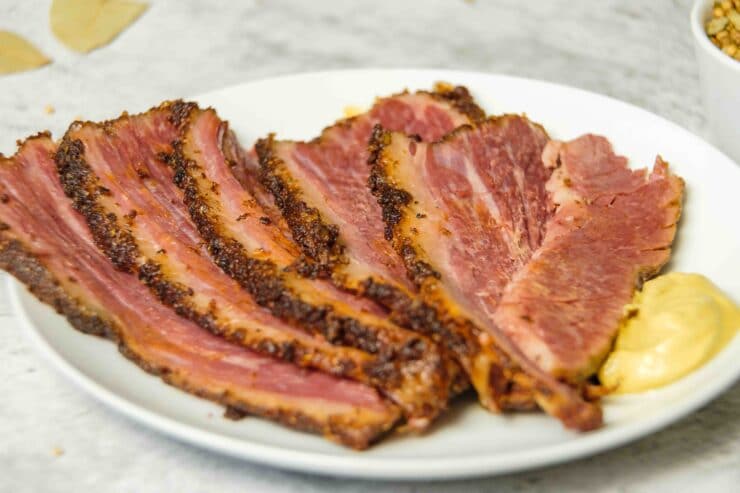
I’ve tried my hand at homemade pastrami several times with varying degrees of success. It wasn’t until a publisher sent me a review copy of The Artisan Jewish Deli at Home that I finally found a recipe worth blogging about. In their fabulous cookbook, authors Nick Zukin and Michael C. Zusman give workable home kitchen recipes for many Jewish deli favorites. In addition to uncovering the secrets of making these classic recipes at home, Nick and Michael delve into the traditional techniques used in deli kitchens. They also include nostalgic profiles of the most famous deli establishments in North America, including Katz’s in New York and Mile End in Montreal.
Nick Zukin helped to open Kenny & Zuke’s Delicatessen in Portland, one of the first Jewish delicatessens “focused on producing artisanal eats.” Michael C. Zusman is a state court judge who also does freelance food and restaurant writing. His bread recipes are currently used at Kenny & Zuke’s.
Deli-style pastrami emerged in New York during the late 19th century and remains a best seller on most deli menus. Because of its lengthy and laborious process, very few delis still cure and carve their own pastrami. Zukin and Zusman have whittled down the process to a very simple, doable recipe that requires relatively little effort. After making a simple brine the meat cures in the refrigerator, then it’s rubbed with a spice blend and left to cook in a slow oven for a few hours. According to the authors:
“Delicatessen aficionados might cringe at the idea of making pastrami in the oven, since wood smoking is supposed to be the customary cooking method. At least that’s what they think. In truth, some of the most lauded pastrami and smoked meat involve no wood smoke at all. In his must read chronicle, Save the Deli, David Sax reveals that the smoky flavor in commercially produced pastrami comes from fat dripping down and sizzling on the gas element of the large ovens that are used.”
Side note: I love Save the Deli, I actually covered it on the blog a few years back.
To add that smoky flavor to the brisket, Zukin and Zusman use a hefty dose of smoked paprika (one of my favorite spices!). The result is delicious, quality pastrami hot and fresh from your own oven. My house smelled just like a deli while it was cooking. The flavor and texture were delightful– tender and flavorful. I tested the recipe multiple times just to make sure it wasn’t a fluke. It’s not. This is some killer pastrami.
I stayed pretty true to Zukin and Zusman’s recipe, though I did adapt it slightly by cutting back on the salt. My first test round was extremely salty– good for a bite or two, but if I’d eaten a few slices I would have puffed up like a balloon. The next testing round I cut the kosher salt in the brine in half. I thought it might be too much and that I’d have to add some back in, but half the salt actually provided the perfect flavor. My five dinner guests taste-tested it for me, and they all agreed that the lower sodium brine it was plenty salty. So I present the recipe with the kosher salt halved; if you prefer to try it as written in the cookbook, use 2 cups of kosher salt in the brine.
Update: Nick Zukin let me know in the comments that they used Diamond large crystal kosher salt, which has less salt per cup than Morton’s. I didn’t realize that salt content varies from brand to brand. I am updating my recipe instructions to reflect the brand of salt we used. Thanks to Nick for the heads up!
Don’t be daunted by the long prep time, the preparation is actually very simple. Most of the time here is spent on curing the pastrami in the refrigerator. After that it’s no more difficult than roasting a brisket on a rack. The results are totally worth the wait. I have to hand it to Nick Zukin and Michael Zusman, this is a genius recipe. Their book has a lot of other great recipes for Jewish deli classics including Classic Deli Sandwich Rye, Onion-Poppy Seed Bialys and Cabbage and Smoked Meat Borscht. If you love deli food like I do, check out The Artisan Jewish Deli at Home. You’ll be glad you did!
What’s your favorite place to get a hot pastrami on rye?
Recommended Products:
We are a participant in the Amazon Services LLC Associates Program, an affiliate advertising program designed to provide a means for us to earn fees by linking to Amazon.com and affiliated sites. As an Amazon Associate I earn from qualifying purchases.
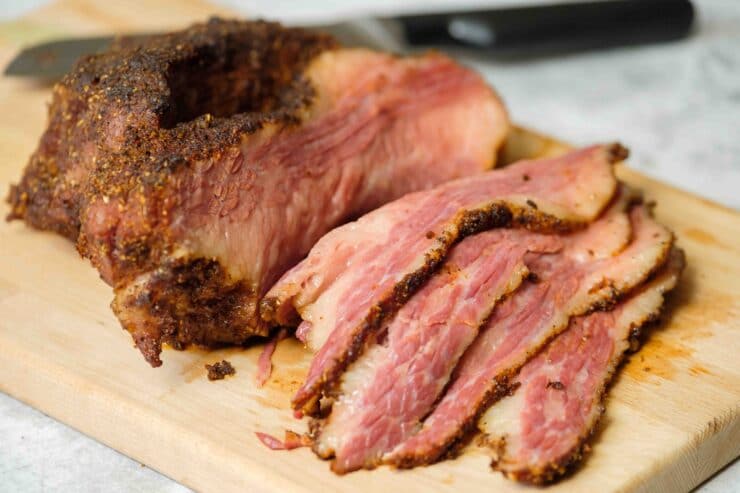
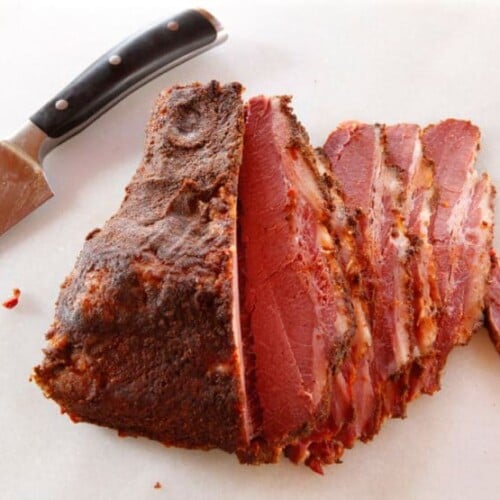
Homemade Pastrami
Ingredients
- 3 quarts water
- 3/4 cup Morton's coarse kosher salt (178 grams) OR 1 1/3 cup Diamond Crystal Kosher Salt (181 grams) - these two brands are NOT interchangeable, the same weight provides two very different cup measurements
- 2 teaspoons pink curing salt (12 grams) - Pink curing salt is also known as Prague Mix #1, Instacure #1 or Curing Salt #1 - NOT Himalayan pink salt. See safety note below.
- 1 cup granulated sugar
- 2 tablespoons pickling spice
- 1 tablespoon whole coriander seeds
- 1 tablespoon whole yellow mustard seeds
- 4 cloves garlic (minced)
- 5 pounds beef brisket
Spice Rub Ingredients
- 1/4 cup ground coriander
- 2 tablespoons freshly ground black pepper
- 2 tablespoons smoked paprika
NOTES
Instructions
- To make the brine, fill a medium to large stockpot with 3 quarts water. Add the kosher and pink salts, granulated sugar, pickling spice, coriander and mustard seeds, and garlic. Bring to a boil over high heat, stirring often to fully dissolve the salt and sugar in the water. Immediately remove the pot from the heat once the brine boils.Add 3 quarts ice cold water to a 2-gallon or larger food-safe container that will fit in your refrigerator (you can also use a strong sealing 2-gallon marination bag - double bag for extra insurance). Pour the brine into the container and place it uncovered in the refrigerator until completely cool. You can also divide the brine evenly between two separate containers so that it will fit better in the refrigerator.

- Trim the fat from the brisket until the fat layer is about 1/4 inch thick.

- If necessary, cut the brisket in half so that it will fit into your container(s).

- Submerge the brisket in the cooled brine.Allow the brisket to brine in the refrigerator for 10 to 12 days, flipping it daily top to bottom and stirring the brine. Make sure that if any of the brisket sides are touching one another you regularly turn them away from each other to expose all of the sides to the brine.

- To cook the brisket, pour 4 cups water into the bottom of a 12 by 15 inch roasting pan. Set a rack inside the pan and place the brisket on the rack, fatty side down.

- To make the spice rub, mix together the coriander, pepper and paprika in a small bowl. Evenly rub 1/4 cup of the mixture onto the top of the brisket. Then flip the brisket and rub the remaining spice mixture onto the fatty side. Allow the brisket to come to room temperature, about 2 hours.

- Preheat the oven to 300 degrees with a rack low enough to fit the pan holding the brisket. Tightly cover the brisket and pan with a double layer of aluminum foil.

- Bake until the meat reaches an internal temperature of 200 degrees, about 1 hour per pound or 5 hours total. Start checking internal temp at 3 hours and periodically every 20-30 minutes or so to avoid overcooking.

- Without trimming the fat, carve the pastrami into 1/4 inch thick slices, or cut as thin as possible without the meat falling apart. Keep tightly wrapped, or in a sealed container in the fridge, for up to 1 week, or in the freezer for up to 6 months.

- SAFETY NOTE: handle the pink curing salt with care and keep it out of reach of children. It is used in pastrami and other cured meats to kill bacteria, prevent botulism and add flavor. However it is extremely toxic if ingested directly; in fact, it's colored pink to prevent people from mistaking it for regular salt. When used with care in recipes like this, it is very safe and necessary for proper flavor and food safety. That said, you should know the risks and keep the curing salt properly labeled and out of the reach of children.

Nutrition

tried this recipe?
Let us know in the comments!
&n
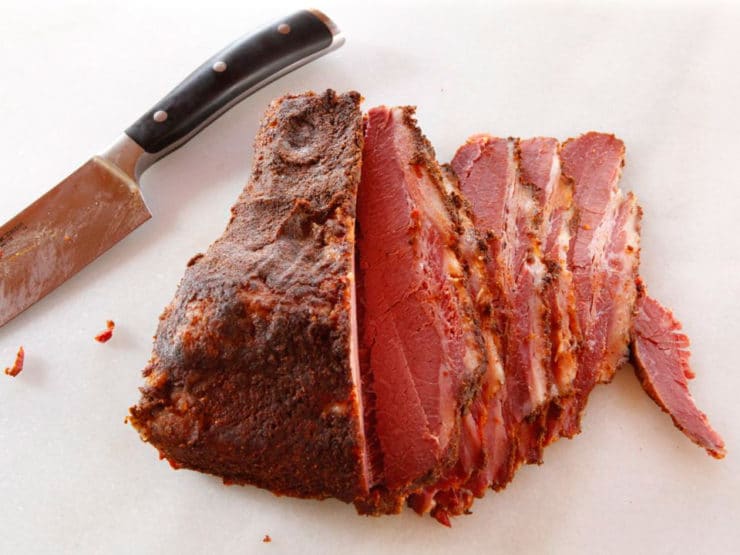
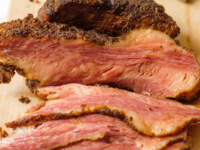
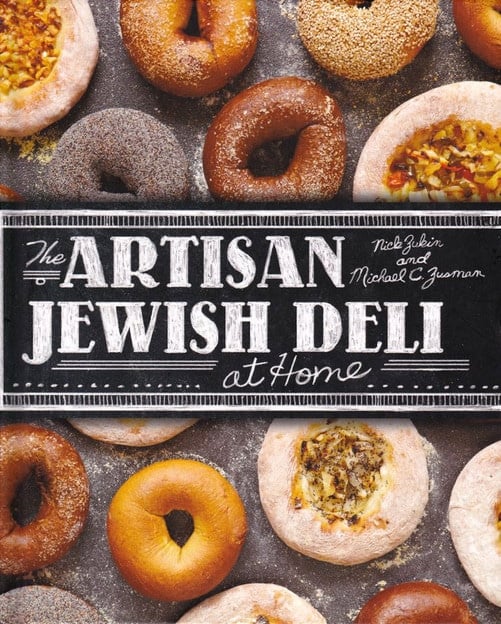
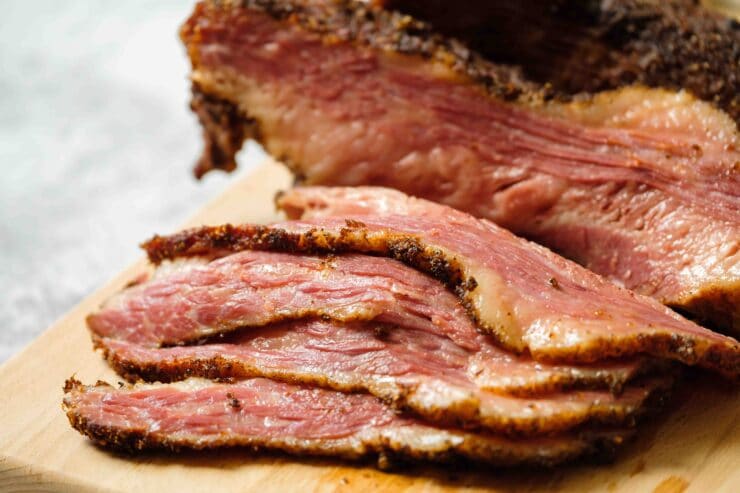

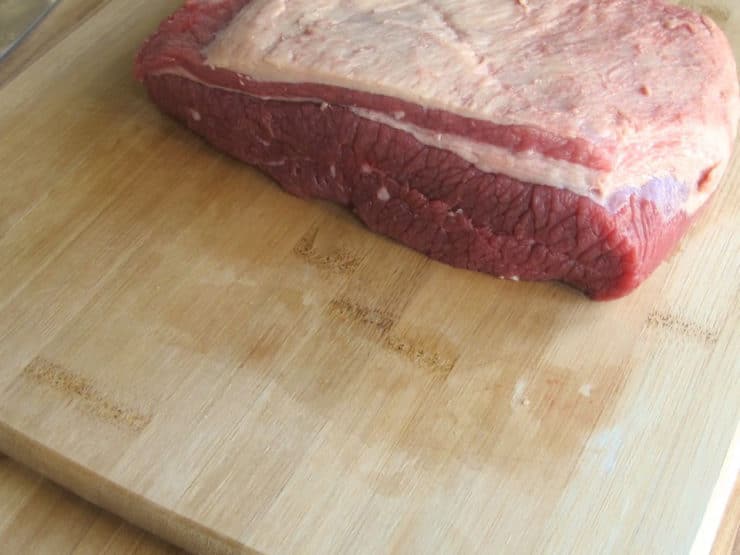
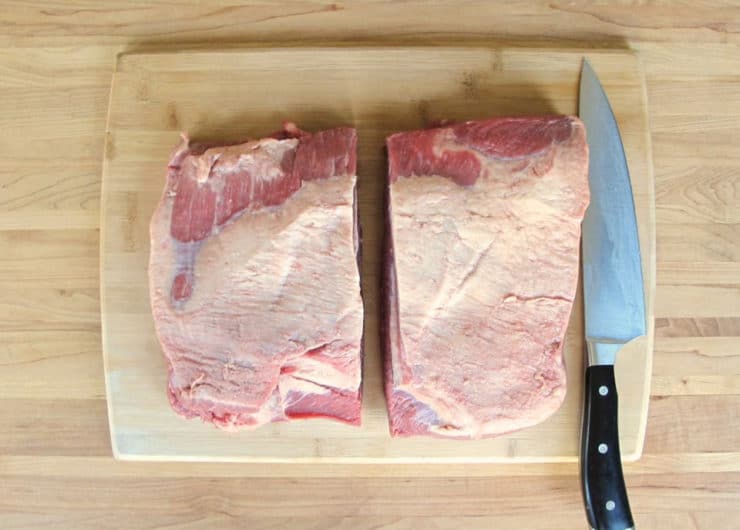

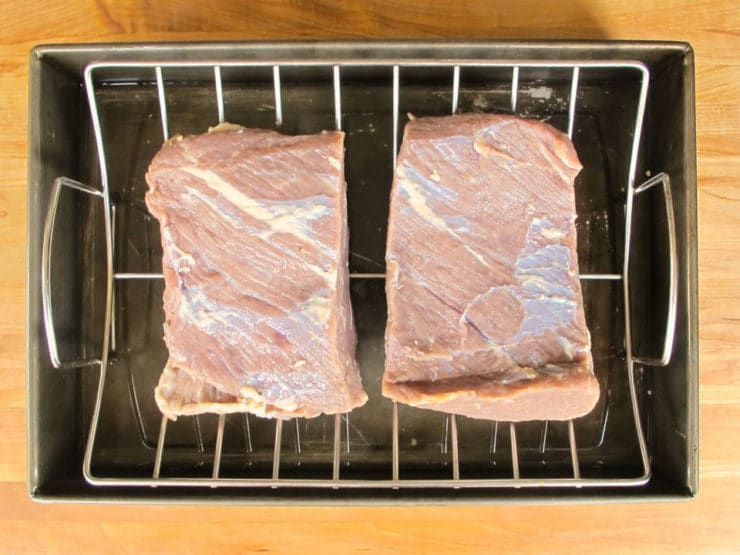
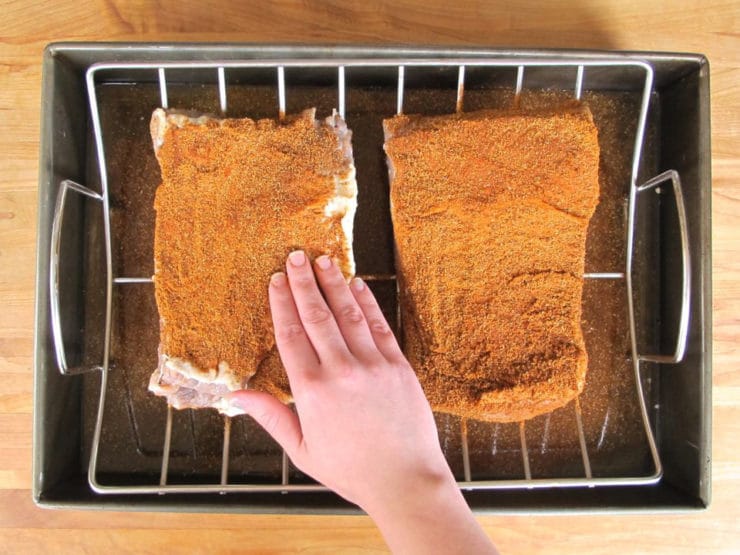
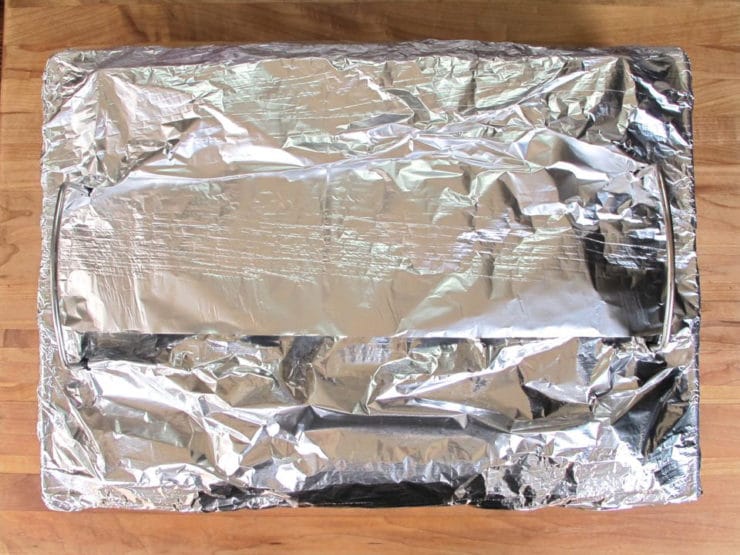
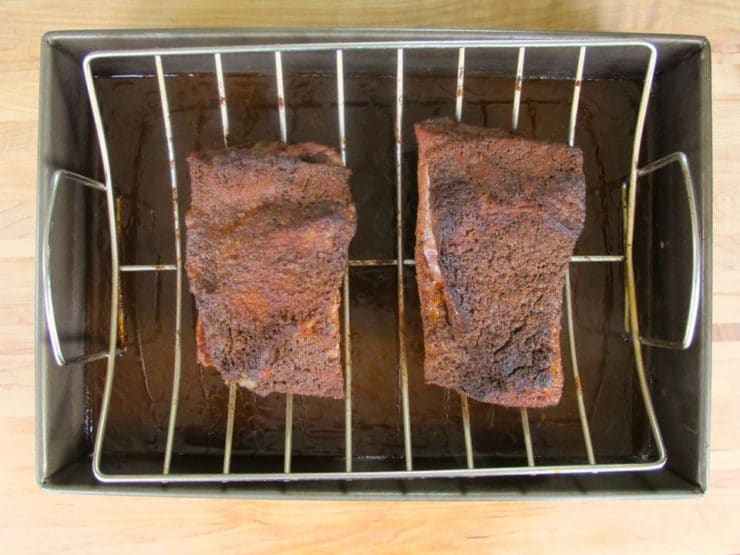
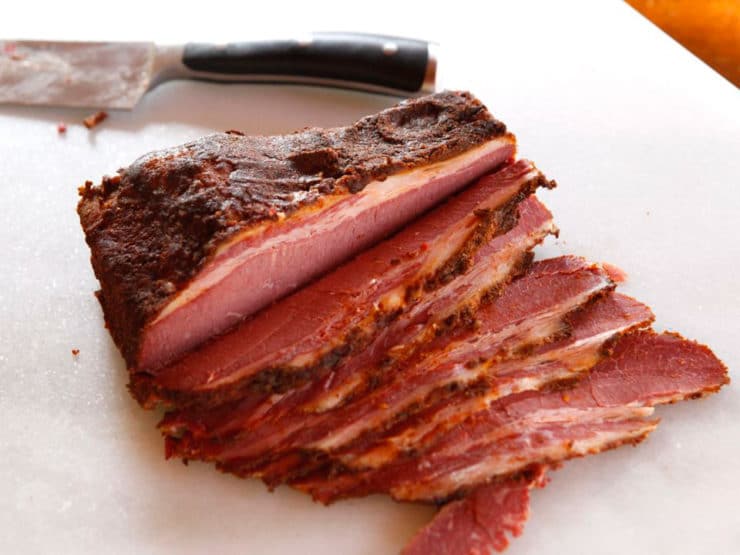
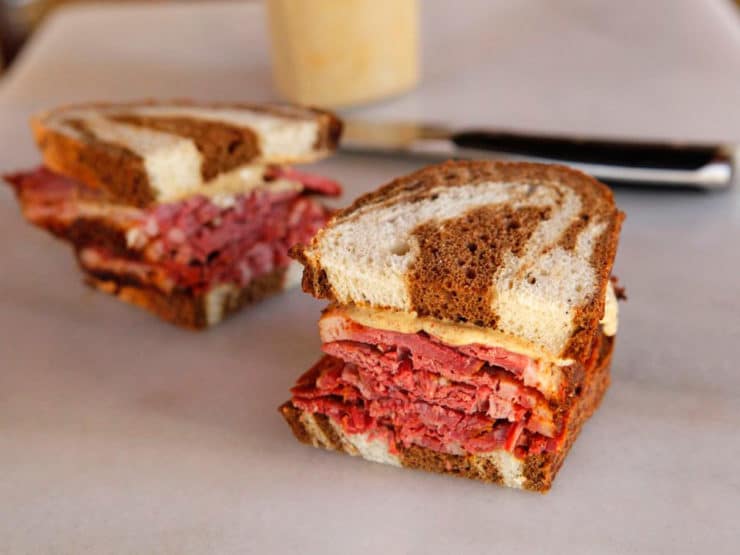


Hi..what can I substitute for the curing salt..or could I just add more other salt.thanks
There is no substitute for curing salt in this recipe.
Excited to try this recipe as I’ve only ever made pastrami from store bought corned beef. I have a question though:
I have a 7 lb brisket that I put in the fridge with your recipe yesterday, except I couldn’t find Pink Curing Salt #1 locally, only Morton’s Tender Quick. I used 2 tsp of Tender Quick. Do you know if I should use more or less Tender Quick than curing salt in this recipe? I’ve added the correct amount of Morton’s Kosher.
My parents had a leftover brisket from their grass-fed beef so I kinda had to use the 7 lb meat.
Open to any advice! I’m less than a day into brining it, so possibly not too late to change it up a bit?
Cheers! R
Hi Rachel– unfortunately I have never worked with Tender Quick, so I cannot advise you on the proper amount to substitute. Sorry!
Great stuff. I added honey and some brown sugar plus onion and garlic. Used this as a baseline and turned out great. I smoked mine on a pellet grill. Thanks for the recipe. The lesser pink salt and longer brine worked like a champ.
I love this recipes simple and to the point. I do have a question. How much meat can you cure with this batch of solution. Is it limited to just 5 pounds? I am planning on doing 10 to 15 pounds of eye of round. Thank you very much Lou Hess.
Thank you I made this with Deer meat and it was delicious
The reason Diamond large crystal kosher salt had less salt out cup it’s the size of the salt crystal. More air with larger crystals. Thanks for updating your recipe.
I haven’tried this yet butI have used a DRY Cure for Salt Brisked and Flank nand in truth prefer it, I make up my nown SALTPETRE CURE at I^ to O.08 percent concentration Plus half the amount of BROWN SUGAR And at a 2.5% of meat weight [25 grammes per kilo of Brisket Flank I know that INSTACURE ONE has the same concentration of SODIUM NITRATE and SODIUM NITRITE though I have no idea as to why this is apparently preferred to KNO3. For a SMOKE Y NFLAVOUR vI usze eithe a good SMOKED PAPRIKA band/or one to two teaspons [approx 5 grammes of LIQUID SMOKE in the original cure. Just like the Commercial boys do and have done for decades.
Sealing the ORIGINAL CURE in a vaccum baag staops too much drying out
What do you think and have you ever used Liquid smoke?
Personally I see no good reason for being ‘traditional just for the sake of it. If that were true nobody would ever use collogen casings aging bags or film would they?
Excellent, exactly as described. Have tried several pastrami recipes both from corned beef and fresh brisket. This is hands down this is the best.
Hi I am glade I still have the old recipe I like it much better
OH! One other comment. I used to have to cut pastrami and use a plastic container to cure the meat. I decided to use a turkey brining bag which is PLENTY big for the brine, covers the meat much better, and is easier to store in the refrigerator!
Hi Tori!
I have a recipe program which imports the recipes from websites (“Home Cookin”) and I had your recipe that I imported a few years ago. I had made some additions…added in a different spice rub to try at some point, after curing….but I somehow screwed up the directions for brining.
When I went back to your site I saw the recipe had drastically changed…and now right before asking you about this, I just saw your update that you had someone redevelop your recipe. I wish I had seen that earlier before starting the brining process. The 2 teaspoons was a big change from 1/4 cup. I ended using about 2 tablespoons because I just wasn’t sure what to do.
I had down that the original brining time (if I’m remembering) was 5-7 days, and now it’s 10-12 days. Is that because the amount of curing salt was cut down? If I use more than the 2 teaspoons curing salt, do I lessen the amount of time for curing?
I saw where you mentioned that pastrami is usually smoked but plenty of delis don’t smoke it. Also, is pastrami *usually* smoked after curing, as opposed to roasting in the oven? I was going to put it on my Pit Barrel Cooker to smoke after curing but then didn’t want to ruin the taste if the smoke imparts the wrong flavors. Do delis, like Katz’s, smoke the pastrami when brining is finished or do they just steam it? Or do they smoke, THEN steam it? 🙂
Your old recipe was delicious so waiting to see how the newer one works.
Should the brisket be rinsed in cold water after the brine time or baked with no rinsing
I can’t wait to try this!!
LOVE your recipe / I have made it a few times with success. Currenty curing an 8 pound whole brisket for Superbowl Sunday. QUESTION: Do I cook it for 8 hours? I do not have a meat thermometer. Please advise!
THX
Excellent recipe. I’ve now made it a few times. I am actually planning on using it again, but on this occasion, I think it will be best to make a few pastramis ahead of time and then freeze them. I’ve never tried that before. So where as the recipe indicates that you can, in fact, freeze the pastramis for up to six months, it doesn’t say how to reheat these pastramis once frozen. Any guidance you can provide would be most helpful. Assuming I’ve defrosted the pastramis, what oven temperature and for what length of cooking time would you recommend (and I’m assuming covered again in a roasting pan containing water on the bottom). I am don’t want to dry them out upon defrosting and reheating.
Thank you so very much.
After removing the meat from the brine does it need to be rinsed under cold water? This will be my first pastrami. The last corned beef I made was very salty and my friend told me I always need to rinse the brine off, prior to smoking/cooking. I am looking forward to trying your recipe. Thanks,
Is the temperature in celsius or farenheit
Farenheit.
I did the recipe to the T. I cut a whole packer brisket into flat and point. Did the cure and then air cured with the rub on over night then rested at room temp for 2hrs prior to smoking. Smoked it at 200 till internal temp of 165ish, had a nice bark set. Then wrapped and ran at 230 till prob tender at 196. It smoked for 12.5 hrs. Turned out great. Will repeat again. I used a choice grade whole packer US beef brisket trimed and separated.
Hi Tory, my husband and his friends are a big fan of the old recipe. Any chance you could post the original in the comments? I pulled up the website to start my brine, and thought I was going crazy not seeing Honey or brown sugar listed, and only 2tsp pink salt. ‘The Boys’ are coming over in 5 days, in anticipation of more delicious Pastrami, so I will try to recreate the old one to the best of my memory, but I don’t have 10 days to wait, and don’t want to so drastically change the flavor on them, either. Thanks!
Hi Mollie, the original recipe can be found in The Artisan Jewish Deli at Home cookbook. The Kindle edition can be purchased and downloaded here: https://www.amazon.com/Artisan-Jewish-Deli-Home-ebook/dp/B00BSHNZUG/?tag=theshiintheki-20
Hi –
I tried the recipe and was disappointed.
Over the years, I’ve eaten in many noteworthy delicatessens: Stage Deli, Carnegie, Katz’s, Shapiros, Manny’s, Canter’s, Kenny & Zuke’s… Of all, Kenny & Zuke’s had the pastrami and corned beef that I enjoyed the most. They did their research and really perfected the recipes. I now eat at K&Z whenever I’m in Portland visiting my kids. It became my new benchmark standard. So, I was particularly intrigued when I found this recipe.
I bought everything fresh, ground my own spices and followed the recipe “to a T”.
– The meat tasted only faintly like corned beef, primarily from the brine.
– There seemed to be little flavor contribution from the rub.
The result only faintly resembled pastrami. Need longer brine time? Need a more concentrated brine? Put on the smoker? I’ll accept any suggestions.
Hi Robert, I’m so sorry to hear that. The recipe you tried has been enjoyed by so many people, I wonder what went wrong for you. At any rate, this recipe was recently updated by my friend Professor Ken Albala (see notes in the recipe above on why). You would have tried the old version depending on the timing of your comment. The new version has a much longer brine time and a bit less sweetness in the brine. The biggest difference is a great reduction in the pink curing salt. It might be worth a try.